The evolution of parasitic plants
About 1% of flowering plants are parasitic, meaning they extract their food from other plants, their so-called hosts. They include the world’s largest flowers, economically important pests, and ecosystem engineers. All parasitic plants possess a special organ, called a haustorium, which attaches to their so-called host plants, penetrates their tissues and draws food and water from them, forming a living physiological bridge between the two plants. Many have abandoned photosynthesis (the so-called holoparasites), and these are now completely dependent on other plants for their existence.
The evolutionary origins of parasitic plants remained unclear for centuries. This is because the shift to parasitism was associated with a degeneration of features traditionally used in plant classification, such as well-developed leaves. At Oxford Botanic Garden we are interested in the processes by which these parasitic plants form new species. This research, started at the University of Bristol, shows that shifting hosts may be a driver of the formation of new species of parasitic plants. Linked to this research, we are now developing a unique research collection of parasitic plants here at Oxford Botanic Garden which includes species that do not exist in cultivation elsewhere.
Endoparasitic plants
Endoparasites spend their entire life cycles within the tissues of other plants except for emerging briefly to flower and set seed. They exist for most of their lives as a hidden endophyte – a series of filaments or masses of cells from which sinkers (analogous to roots) tap into the conducting tissues within their host plants’ roots and stems.
Our recent work, carried out in collaboration with scientists at the Harvard University Herbaria and University of São Paulo, reviews the extent to which these extraordinary ‘plants that live inside plants’ show similarities to fungi – organisms that belong to a different kingdom altogether. The parallels are particularly clear in biotrophic fungi – those that derive nutrients from living tissues. Both groups produce organs for penetrating their hosts and extracting nutrients from them, and both show filamentous growth within their hosts’ tissues.
In the transition this extreme life history, endoparasitic plants and fungi have both lost genes. For example, the genes needed for photosynthesis are missing in many parasitic plants, meanwhile those used to encode certain enzymes in some fungi are also redundant. Besides gene loss, the intimate associations between plants and fungi and their hosts have also led to the accumulation of new genes: so-called horizontal gene transfers (HGTs) – the rare exchange of genetic material between non-mating organisms, which has been shown to be unusually frequent in parasitic plants. Plants in the Rafflesiaceae (a family containing the world’s largest flowers) contain genes from the cucumber and carrot relatives, presumably reflecting past associations with hosts from these families. Thus these HGTs can be thought of as ‘DNA fossils’ – clues that scientists can use to unravel the complex puzzle of extinct relationships among plants that spans evolutionary time. The connection between a parasitic plant and its host can also facilitate the movement of viruses, proteins, and RNA (which acts as a messenger, carrying the instructions of the DNA). Astonishingly, some parasitic plants and fungi have evolved strategies to infect their hosts through RNA-based communication and ‘molecular camouflage’ – stealthily invading their hosts, unnoticed. For example, some fungi have been shown to use molecular messaging to disarm their hosts’ immune responses.
Staff at Oxford Botanic Garden are propagating some of these unusual plants, which are rare in cultivation, for research and conservation purposes.
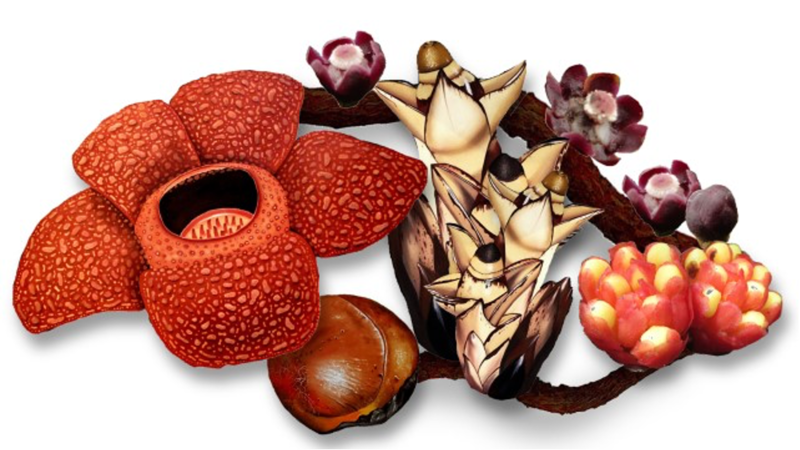
The four families of endoparasitic plants include the world’s largest flower – Rafflesia (left), Mitrastemon (centre), Cytinus (right), and Pilostyles (top).
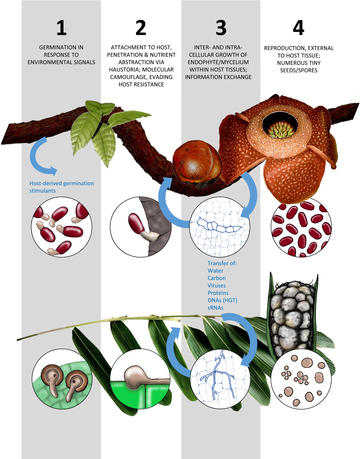
The simplified life cycle of an endoparasitic plant (above: Rafflesia), and a biotrophic fungus (below: Ustilago maydis) in which the key phases are highlighted and patterns of convergence summarized. Figure sourced from Thorogood, et al. (2021)
Broomrapes (Orobanche)
Oxford Botanic Garden has a specific research and conservation focus on broomrapes (Orobanche), especially those that are native to the UK. Broomrapes (Orobanche L. family Orobanchaceae) are among Britain’s most curiously beautiful yet least understood plants. They are renowned for being taxonomically challenging. Plants which are distinct in the field can become brown and featureless when pressed which has led to the incorrect determination of herbarium specimens. This confusion has been compounded by intra-specific variation in some species, confusing synonymies, names cited incorrectly, and species with poor type specimens and descriptions.
Our work carried out in collaboration with Dr Fred Rumsey at London’s Natural History Museum examines the host range and taxonomic complexity of common broomrape (Orobanche minor Sm.), the most widespread and variable species in the British Isles. Based on morphology, ecology and molecular data, we recently described two new varieties of O. minor s.l. that are ecologically distinct within the broader context of cryptic taxa in the subsection Minores. Our work suggests that delineating taxa objectively and reliably is important for informing conservation priorities. Host identity and ecology, besides morphology, are essential considerations when identifying infraspecific taxa in this taxonomically challenging species. We are cultivating these taxa, along with other Orobanche species in the Botanic Garden, and a small selection are grown seasonally on public display.
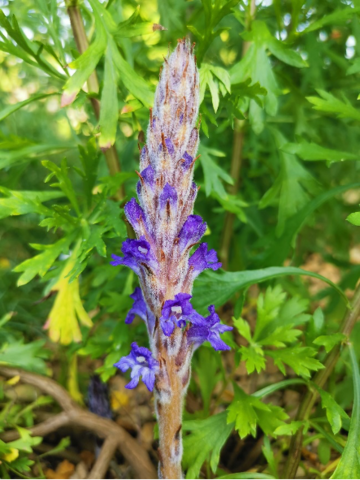
Orobanche coerulescens in cultivation at Oxford Botanic Garden, grown from seed collected in Japan. This is the first record of this plant in cultivation in the UK.
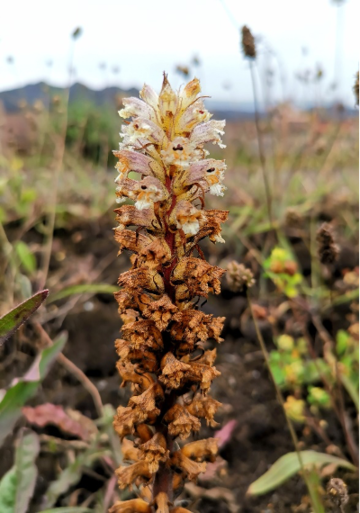
Orobanche picridis is among Britain’s rarest plants. This species has been cultivated successfully in the parasitic plant research collection at Oxford Botanic Garden.
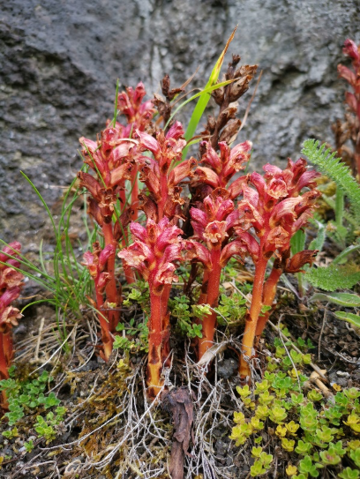
Orobanche alba growing wild in Northern Ireland.
Tropical parasites
Together with local botanists and conservationists, scientists at Oxford Botanic Garden work on taxonomically complex groups of parasitic plants and mycoheterotrophs (parasites that obtain their carbon from fungi). So-called ‘fairy lanterns’ (genus Thismia) are among the most extraordinary-looking of all flowering plants. They grow in the depths of remote rainforests where they are seldom seen by people. There are c. 90 species worldwide, distributed across the forests of Asia, Australasia, South America, and the USA. They lack true leaves and chlorophyll, obtaining their food from root-associated fungi shared with other green plants. Their mysterious flowers emerge just briefly, and often under leaf litter.
Together with botanists in Malaysia, we recently described a new species of fairy lantern called Thismia sitimeriamiae. It was first discovered by rainforest explorer Dome Nikong in 2019 who found the plant on Gunung Sarut, a mountain located in the Hulu Nerus Forest Reserve in the state of Terengganu. The flower’s shape, colour and surface characteristics are unique in the genus. Thismia sitimeriamiae has pillar-like structures holding up a so-called ‘mitre’ – an umbrella-like structure, the function of which is a mystery. The extraordinary architecture of the flower raises interesting questions about how it is pollinated. Other species of Thismia are pollinated by little fungus gnats, but the ecology of most species is a mystery.
Our scientists work with collaborators in Malaysia and the Philippines on poorly known parasitic plant groups.

Thismia sitimeriamiae. Image from Siti-Munirah et al., 2021 https://phytokeys.pensoft.net/article/68300/
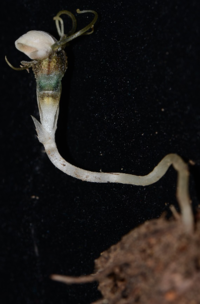
Thismia species from the rainforests of Malaysia. Images from Thorogood & Siti-Munirah., 2021: https://nph.onlinelibrary.wiley.com/doi/full/10.1002/ppp3.10217
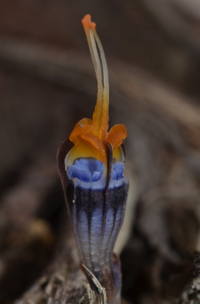
Thismia species from the rainforests of Malaysia. Images from Thorogood & Siti-Munirah., 2021: https://nph.onlinelibrary.wiley.com/doi/full/10.1002/ppp3.10217
Hydnora
A recent project started in collaboration with scientists at Royal Botanic Gardens Kew and the University of Sheffield, seeks to examine the evolution of host-parasite interactions and speciation in the genus Hydnora (Aristolochiaceae). Hydnora are extraordinary-looking parasitic plants that are distributed across southern and eastern Africa, Madagascar, and southern Arabia and are among the earliest diverging lineages of parasitic plants, so an ideal group with which to explore the evolution of parasitism. Our approach will combine molecular phylogenetic and physiological data to examine how host shifts may have shaped species diversity and divergence in the genus.
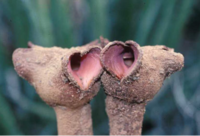
Hydnora triceps, photo by Lytton Musselman, sourced from Thorogood, 2018: https://nph.onlinelibrary.wiley.com/doi/full/10.1002/ppp3.9
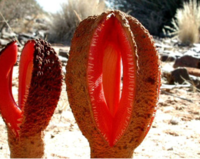
Hydnora visseri, photo by Lytton Musselman, sourced from Thorogood, 2018: https://nph.onlinelibrary.wiley.com/doi/full/10.1002/ppp3.9
Selected References:
Thorogood CJ, Teixeira-Costa L, Ceccantini G, Davis C, Hiscock SJ. 2021. Endoparasitic plants and fungi show evolutionary convergence across phylogenetic divisions. New Phytol. doi: 10.1111/nph.17556.
Siti-Munirah MY, Dome N, Thorogood CJ. 2021. Thismia sitimeriamiae (Thismiaceae), an extraordinary new species from Terengganu, Peninsular Malaysia. PhytoKeys. 29;179:75-89.
Thorogood CJ, Siti-Munirah MY. 2021. Fairy lanterns in focus. Plants People Planet. 1– 5. https://doi.org/10.1002/ppp3.10217
Thorogood C, Rumsey F. 2021. Broomrapes of Britain and Ireland. BSBI.
Thorogood C, Rumsey F. 2020. An account of common broomrape Orobanche minor (Orobanchaceae) in the British Isles British & Irish Botany 2(3):223-239.
Thorogood CJ, 2019. Hydnora: The strangest plant in the world? Plants People Planet. DOI: 10.1002/ppp3.9
Thorogood CJ, Hiscock SJ (2010). Specific developmental pathways underlie host specificity in the parasitic plant Orobanche. Plant Signaling and Behaviour 14: 5(3).
Thorogood CJ, Rumsey FJ, Hiscock SJ (2009). Seed viability determination in parasitic broomrapes (Orobanche and Phelipanche) using fluorescein diacetate staining. Weed Research 49: 461-468.
Thorogood CJ, Rumsey FJ, Harris S and Hiscock SJ (2009). Host-mediated gene flow in the parasitic angiosperm Orobanche minor (Orobanchaceae). Plant Systematics and Evolution 282: 31-42.
Thorogood CJ (2008). Host specificity and speciation in parasitic plants. Haustorium 54: 1-3.
Thorogood CJ, Rumsey FJ, Hiscock SJ (2008). Host-specific races in the holoparasitic angiosperm Orobanche minor: implications for speciation in parasitic plants. Annals of Botany 103: 1005-1014.
Thorogood CJ, Rumsey FJ, Harris S and Hiscock SJ (2008). Host driven divergence in the parasitic plant Orobanche minor sm. Molecular Ecology 17: 4289-4303.
Thorogood CJ, Hiscock SJ (2007). Host Specificity in the Parasitic Plant Cytinus hypocistis. Research Letters in Ecology 84234.



